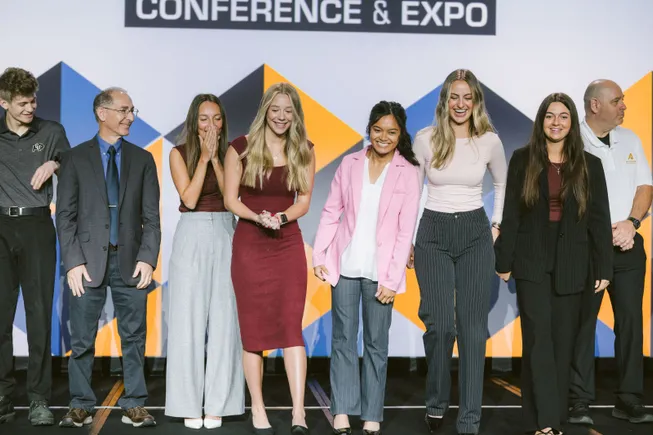The construction industry faces a stark shortage of workers, but programs and people across the country are working at the local level to solve the problem. This series highlights those efforts helping to recruit the next generation of construction pros. Read previous entries here.
Do you know of a group that is helping to attract workers to the construction industry? Let us know.
The Yellowstone International Airport megaproject has selected a team to design and build its $100 million terminal expansion. Well, not really, seeing as no such airport or project exists.
In fact, it was part of the Design-Build Institute of America’s recent student competition, which sought to teach students about the project delivery method and simulate bidding on the imaginary project.
A team of students from the University of Arizona — Cardinal Design-Build — won the competition, held at the DBIA conference in Dallas in November.
“It was totally out of the box, but the students jumped on it like a duck on a junebug, like we say down here in Texas,” said Bill Hasbrook, student and academia liaison for the DBIA and the competition’s organizer.
Hasbrook said this was his first year organizing the competition, which has in the past focused on imaginary buildings on student campuses. Instead, this year, Hasbrook changed the game by having teams across eight regions compete to assemble a design-build package for the same pretend RFP. From those regions, the top three advanced to present their bid to a panel of judges at DBIA’s national conference.
The RFP sought to get the biggest scope of work for the $100 million budget, expecting the teams to plan for every cent, Hasbrook said. That meant they had to factor in how many gates they could fit versus retail spaces for revenue generation. Judges and DBIA leaders were impressed with the creativity.
“It’s a continuing awe at what the students are able to provide,” said Salvador Chairez, senior manager of component relations for DBIA. “They provide a lot of comfort about the future of design-build.”
Chairez and Hasbrook said that the competition aims to continue to spread the word about design-build delivery methods to construction’s future leaders, while also educating the students and providing them with real-world, resume-building experiences.
The winning team
Lily Trenkamp, 20, is an architectural engineering major at the Tucson, Arizona, university. Originally from Des Moines, Iowa, she hopes to pursue a structural engineering career in residential construction.
Trenkamp said the competition helped her learn about construction processes that she doesn’t get from classroom lectures, such as schedules and cost estimating.
Trenkamp and teammate Lauren Johnson took on the lead design of the airport, using Revit for floor plans. She said that the design posed a challenge, but she had taken classes to learn Revit before.
“However, the task of designing an airport from scratch was very daunting at first and the quick turnaround time of this project had us cramming to finish it,” she said.
Hasbrook admitted the time from RFP to bid presentation was brief. Students had three months to pull together bids.
“If we had that much time to bid in real life I’d probably pass because it’s too short,” he said.
Reuel Florendo, a junior at the University of Arizona and the team’s captain, had competed in the DBIA event before but said she learned a lot from the latest competition.
“In the first phase of the competition, the RFQ phase, teams were asked to demonstrate relevant experience on three past projects. Our team took that opportunity to research real-world airport terminals and determine what features of those terminals we’d like to include in ours,” Florendo said. “The challenging part of this project was not having an existing terminal to base our expansion off of, but we were able to work together as a team to come up with a creative workaround.”
The five-person squad was made up entirely of women. Trenkamp said it was “encouraging” and has made her more confident.
“I hope our story inspires groups who are underrepresented in this field to embrace challenges as opportunities for growth,” Florendo added.
